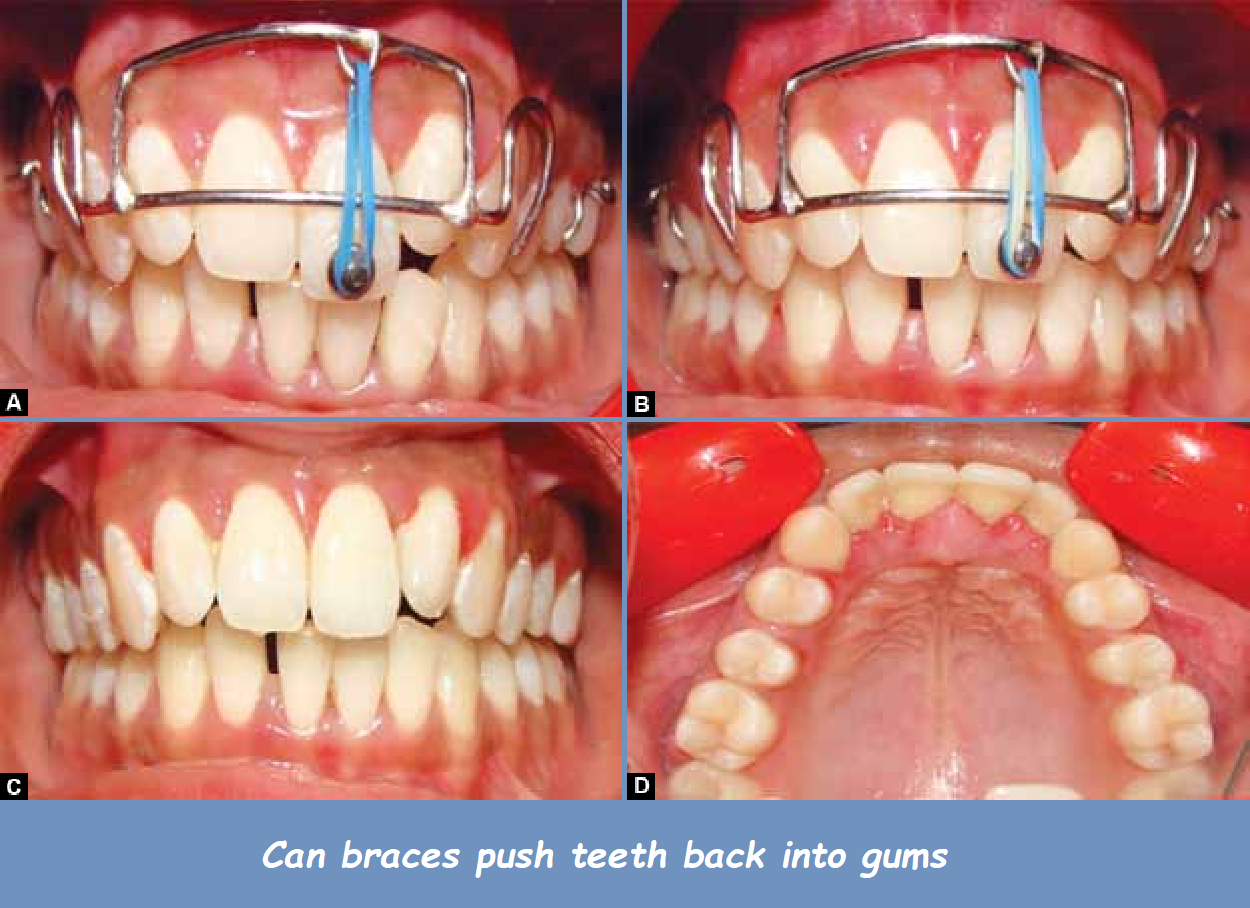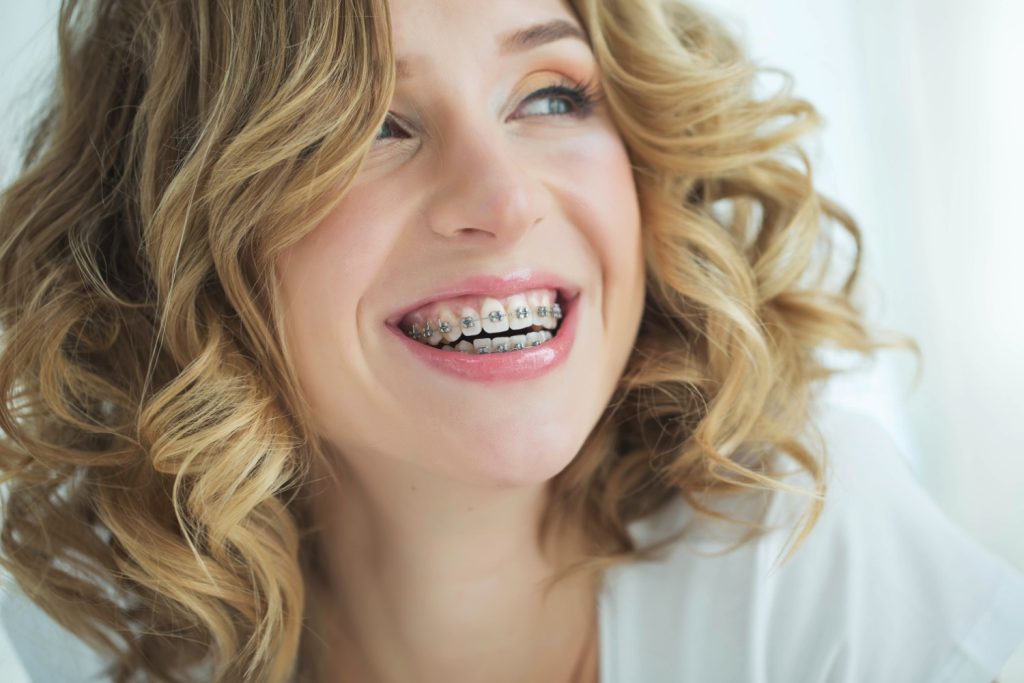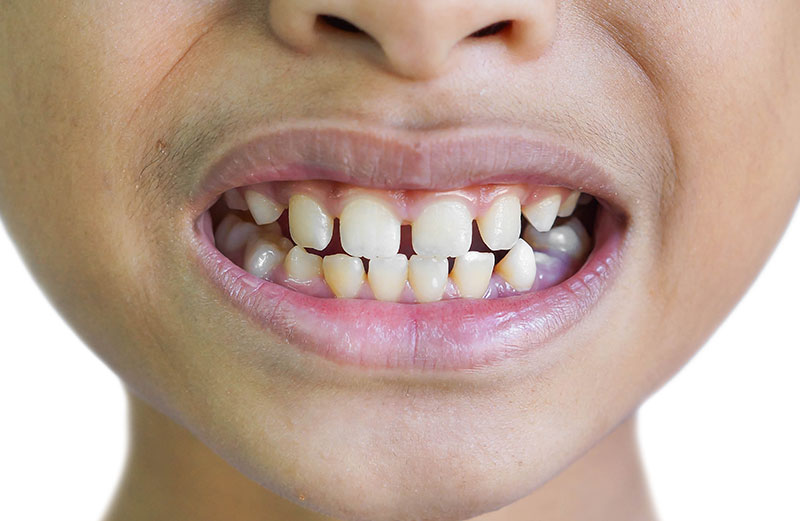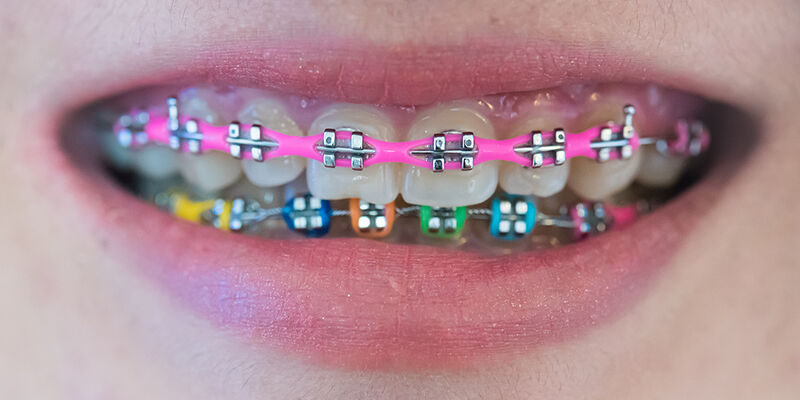Can braces push teeth back into gums

Braces are a common and effective orthodontic treatment used to correct misaligned teeth, crooked smiles, and various bite issues. However, some people have concerns or questions about how braces work, including whether they can push teeth back into the gums. This concern often arises from a misunderstanding of how braces move teeth and the role of orthodontic treatment in reshaping the dental structure.
In this guide, we’ll explore how braces function, address the concern about whether braces can push teeth back into the gums, and explain what actually happens during orthodontic treatment. We’ll also discuss the benefits of braces, potential side effects, and how to ensure a successful and safe treatment outcome.
How Do Braces Work?
Before addressing the specific concern about teeth being pushed back into the gums, it’s important to understand how braces move teeth and what orthodontic treatment involves.
1. Components of Braces
Braces consist of several key components that work together to move your teeth into their desired positions:
- Brackets: These small metal or ceramic pieces are attached to the front surface of each tooth with a special adhesive. Brackets serve as anchors for the archwires.
- Archwires: The archwire is a thin metal wire that runs through the brackets. It applies continuous pressure to the teeth, guiding them into the correct alignment over time.
- Bands: Orthodontic bands are metal rings that are sometimes placed around the molars to provide additional support for the archwire.
- Elastic Ligatures: These small rubber bands hold the archwire in place within the brackets. They come in various colors and are replaced at each orthodontic visit.
- Springs and Rubber Bands: Additional components, such as springs or rubber bands (elastics), may be used to apply specific forces to move teeth in certain directions.
2. The Process of Moving Teeth
The movement of teeth with braces is a gradual and carefully controlled process. Here’s how it works:
- Applying Pressure: The archwire, which is attached to the brackets, applies continuous pressure to the teeth. This pressure is what causes the teeth to move over time.
- Bone Remodeling: When pressure is applied to a tooth, the bone on one side of the tooth (where the pressure is applied) begins to break down, while new bone forms on the opposite side. This process is known as bone remodeling and is what allows the tooth to move within the jawbone.
- Tooth Movement: As the bone remodels, the tooth gradually shifts into the desired position. This process happens slowly to ensure that the tooth remains healthy and stable throughout treatment.
Can Braces Push Teeth Back into the Gums?
The concern that braces could push teeth back into the gums is based on a misunderstanding of how braces work. Braces are designed to move teeth within the jawbone, but they do not push teeth into the gums or cause them to recede into the jaw. Here’s why:
1. Controlled Movement
Orthodontic treatment is a carefully controlled process that involves precise movements of the teeth. The pressure applied by braces is gentle and gradual, allowing teeth to move through the bone in a controlled manner. This movement is monitored regularly by an orthodontist to ensure that the teeth are shifting correctly and safely.
2. Bone Remodeling, Not Gum Movement
When teeth move in response to braces, it’s the bone surrounding the teeth that undergoes remodeling, not the gums. The gums may adapt to the new position of the teeth, but they are not pushed back into the jaw. The role of the gums is to support the teeth, and they generally follow the position of the teeth as they move, maintaining a healthy attachment.
3. Prevention of Excessive Force
Orthodontists are trained to apply the correct amount of force needed to move teeth without causing damage. Excessive force could potentially harm the teeth or surrounding tissues, but modern orthodontic techniques are designed to avoid this. The goal is to move teeth into their ideal positions without causing any adverse effects on the gums or bone.
Understanding Potential Side Effects of Braces
While braces are safe and effective, like any medical treatment, they can have some side effects. However, these side effects are usually mild and manageable:
1. Gum Sensitivity
During orthodontic treatment, you may experience some gum sensitivity or mild inflammation, especially after adjustments. This is usually temporary and can be managed with good oral hygiene and regular dental visits.
2. Gum Recession
In rare cases, some patients may experience gum recession during orthodontic treatment. This occurs when the gum tissue pulls away from the teeth, exposing more of the tooth’s root. Gum recession can be caused by a variety of factors, including aggressive brushing, existing gum disease, or improper orthodontic techniques. If you notice signs of gum recession, it’s important to consult your orthodontist and dentist for evaluation and treatment.
3. Root Resorption
Root resorption is a condition where the root of a tooth becomes shorter during orthodontic treatment. This occurs when the body’s natural remodeling process breaks down some of the tooth’s root structure. While mild root resorption is common and usually not a cause for concern, severe cases can weaken the tooth. Your orthodontist will monitor your teeth throughout treatment to minimize the risk of significant root resorption.
4. Tooth Mobility
As teeth move during orthodontic treatment, they may feel slightly loose. This is normal and temporary, as the teeth are adjusting to their new positions. Once treatment is complete and the teeth have settled, they will regain their stability.
Benefits of Braces
Despite the potential side effects, the benefits of braces far outweigh the risks. Orthodontic treatment can have a positive impact on both your oral health and overall well-being:
1. Improved Alignment and Bite
The primary benefit of braces is the correction of misaligned teeth and bite issues. Proper alignment can improve your ability to chew, speak, and clean your teeth effectively, reducing the risk of cavities and gum disease.
2. Enhanced Aesthetics
A straight smile can boost your confidence and self-esteem. Braces help create a more aesthetically pleasing smile, which can have positive social and psychological effects.
3. Prevention of Dental Problems
Correcting misaligned teeth and bite issues can prevent future dental problems, such as excessive wear on certain teeth, jaw pain, and temporomandibular joint (TMJ) disorders.
4. Better Oral Health
Straighter teeth are easier to clean, which can lead to better oral hygiene and a reduced risk of plaque buildup, tooth decay, and gum disease.
How to Ensure a Successful Orthodontic Treatment
To ensure that your orthodontic treatment is successful and that your teeth are moved safely into their new positions, follow these guidelines:
1. Choose a Qualified Orthodontist
It’s essential to choose an experienced and qualified orthodontist to oversee your treatment. An orthodontist is a dentist who has completed additional training in the diagnosis, prevention, and treatment of dental and facial irregularities.
2. Follow Your Orthodontist’s Instructions
Your orthodontist will provide specific instructions on how to care for your braces and manage your treatment. Follow these instructions carefully, including wearing any prescribed elastics, avoiding certain foods, and attending all scheduled appointments.
3. Maintain Good Oral Hygiene
Brushing and flossing regularly is crucial when you have braces. Proper oral hygiene helps prevent plaque buildup, cavities, and gum disease, which can complicate your orthodontic treatment.
4. Attend Regular Check-Ups
Regular check-ups with your orthodontist are essential for monitoring your progress and making any necessary adjustments to your braces. These appointments also allow your orthodontist to detect and address any potential issues early on.
5. Communicate Concerns
If you have any concerns or experience unusual symptoms during your treatment, such as excessive gum sensitivity, pain, or changes in tooth mobility, don’t hesitate to contact your orthodontist. Open communication ensures that any issues are addressed promptly.
Alternatives to Traditional Braces
If you’re concerned about the effects of traditional braces, there are alternative orthodontic treatments available that may better suit your needs:
1. Invisalign
Invisalign is a popular alternative to traditional braces that uses clear, removable aligners to gradually move teeth into place. Invisalign is less noticeable and offers more flexibility in terms of eating and cleaning your teeth.
- Pros:
- Virtually invisible
- Removable for eating and cleaning
- Comfortable and less likely to cause gum irritation
- Cons:
- Not suitable for all types of orthodontic issues
- Requires strict compliance with wearing aligners for the recommended 22 hours per day
2. Lingual Braces
Lingual braces are similar to traditional braces, but they are attached to the back (lingual) surfaces of the teeth, making them less visible from the front.
- Pros:
- Hidden from view, offering a more aesthetic option
- Effective for complex orthodontic cases
- Cons:
- More challenging to clean
- May cause initial discomfort to the tongue
3. Ceramic Braces
Ceramic braces work like traditional metal braces but use tooth-colored or clear brackets, making them less noticeable.
- Pros:
- Less visible than metal braces
- Effective for a wide range of orthodontic issues
- Cons:
- More fragile than metal braces
- Larger brackets can cause gum irritation
Conclusion: Can Braces Push Teeth Back into Gums?
The concern that braces can push teeth back into the gums is unfounded. Braces are designed to move teeth within the bone, not to push them into the gums. Orthodontic treatment is carefully controlled, with the goal of aligning teeth in a healthy and aesthetically pleasing manner without harming the gums or underlying bone.
Orthodontic treatment offers numerous benefits, including improved alignment, better oral health, and enhanced confidence. By choosing a qualified orthodontist and following their instructions, you can ensure that your treatment is safe, effective, and tailored to your unique needs.
If you have any concerns about how braces might affect your teeth or gums, it’s important to discuss them with your orthodontist. They can provide detailed explanations and reassurance, helping you feel confident in your journey toward a healthier, straighter smile.








